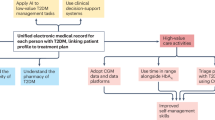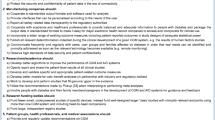Abstract
Since the early 2000s, continuous glucose monitoring (CGM) technology has advanced to become a standard of care in the treatment of type 1 diabetes. Unfortunately, CGM use is not commonly integrated into practice. This article will review the history, technology, and need for systematic training in CGM. Additionally, it will review recent clinical trial data demonstrating the benefits that CGM offers to all people with type 1 diabetes and the clinicians who care for them.

Similar content being viewed by others
Abbreviations
- AP:
-
Artificial pancreas
- BC:
-
Bolus calculators
- CGM:
-
Continuous glucose monitoring
- MARD:
-
Mean absolute relative difference
- SMBG:
-
Self monitoring of blood glucoseT1DM, Type 1 diabetes mellitus
- YSI:
-
Yellow Springs Instrument 2300 STAT Plus Glucose Analyzer
References
Papers of particular interest, published recently, have been highlighted as: • Of importance
Bailey TS, Grunberger G, Bode B, et al. American Association of Clinical Endocrinologists and American College of Endocrinology 2016 outpatient glucose monitoring consensus statement. Endocr Pract. 2016;22(2):231–61. A current review of glucose monitoring placing CGM in perspective.
Miller KM, Beck RW, Bergenstal RM, et al. Evidence of a strong association between frequency of self-monitoring of blood glucose and hemoglobin A1c levels in T1D exchange clinic registry participants. Diabetes Care. 2013;36:2009–14.
Christiansen M, Bailey T, Watkins E, et al. A new-generation continuous glucose monitoring system: improved accuracy and reliability compared with a previous-generation system. Diabetes Technol Theraputics. 2013;15(10):881–7. doi:10.1089/dia.2013.0077.
Miller KM, Foster NC, Beck RW, et al. Current state of type 1 diabetes treatment in the U.S.: updated data from the T1D exchange clinic registry. Diabetes Care. 2015;38:971–8. doi:10.2337/dc15-0078.
Liebing C, Erbach M, Schnell O, Haug C, Freckmann G. Glucose monitoring with a newly developed sensor system-step and time analysis. Diabetes Stoffwechsel und Herz. 2016;25(1):23–9.
Blevins TC. Professional continuous glucose monitoring in clinical practice 2010. J Diabetes Sci Technol. 2010;4(2):440–56.
Juvenile Diabetes Research Foundation Continuous Glucose Monitoring Study Group. Continuous glucose monitoring and intensive treatment of type 1 diabetes. N Engl J Med. 2008;359:1464–76. doi:10.1056/NEJMoa0805017.
Beck RW, Hirsch IB, Laffel L, et al. The effect of continuous glucose monitoring in well-controlled type 1 diabetes. Diabetes Care. 2009;32:1378–83. doi:10.2337/dc09-0108.
Radermecker RP, Saint Remy A, Scheen AJ, Bringer J, Renard E. Continuous glucose monitoring reduces both hypoglycaemia and HbA1c in hypoglycaemia-prone type 1 diabetic patients treated with a portable pump. Diabetes Metab. 2010;36(5):409–13.
Battelino T, Liabat S, Veeze HJ, et al. Routine use of continuous glucose monitoring in 10501 people with diabetes mellitus. Diabet Med. 2015;32(12):1568–74. doi:10.1111/dme.12825.
Heinemann L, Freckmann G. CGM Versus FGM; or, continuous glucose monitoring is not flash glucose monitoring. J Diabetes Sci Technol. 2015;9(5):947–50. doi:10.1177/1932296815603528.
Lee JM, Hirschfeld E, Wedding J. A Patient-Designed Do-It-Yourself Mobile Technology System for Diabetes: Promise and Challenes for a New Era in Medicine. JAMA. 2016;315(14):1447–148. doi:10.1001/jama.2016.1903.
Bailey TS, Zisser HC, Garg SK. Reduction in hemoglobin A1C with real-time continuous glucose monitoring: results from a 12-week observational study. Diabetes Technol Terpautics. 2007;9(3):203–10. doi:10.1089/dia.2007.0205.
Garg SK, Schwartz S, Edelman SV. Improved glucose excursions using an implantable real-time continuous glucose sensor in adults with type 1 diabetes. Diabetes Care. 2004;27(3):734–8.
Edelman SV, Bailey TS. Continuous glucose monitoring health outcomes. Diabetes Technol Ther. 2009;11(supplement 1):S68–74. doi:10.1089/dia.2009.0012.
The Juvenile Diabetes Research Foundation Continuous Glucose Monitoring Study Group. Sustained benefit of continuous glucose monitoring on a1c, glucose profiles, and hypoglycemia in adults with type 1 diabetes. Diabetes Care. 2009;32(11):2047–9. doi:10.2337/dc09-0846.
Juvenile Diabetes Research Foundation Continuous Glucose Monitoring Study Group. Factors predictive of use and of benefit from continuous glucose monitoring in type 1 diabetes. Diabetes Care. 2009;32(11):1947–53. doi:10.2337/dc09-0889.
Chase HP, Beck RW, Xing D, et al. Continuous glucose monitoring in youth with type 1 diabetes: 12-month follow-up of the Juvenile Diabetes Research Foundation continuous glucose monitoring randomized trial. Diabetes Technol Therapeutics. 2010;12(7):507–15. doi:10.1089/dia.2010.0021.
Bergenstal RM, Tamborlane WV, Ahmann A, et al. Effectiveness of sensor-augmented insulin-pump therapy in type 1 diabetes. N Engl J Med. 2010;363(4):311–20. doi:10.1056/NEJMoa1002853.
Bergenstal RM, Tamborlane WV, Ahmann A, et al. Sensor-augmented pump therapy for A1C reduction (STAR 3) study: results from the 6-month continuation phase. Diabetes Care. 2011;34(11):2403–5. doi:10.2337/dc11-1248.
Slover RH, Welsh JB, Criego A, et al. Effectiveness of sensor-augmented pump therapy in children and adolescents with type 1 diabetes in the STAR 3 study. Pediatr Diabetes. 2012;13(1):6–11. doi:10.1111/j.1399-5448.2011.00793.x.
The Value of continuous glucose monitoring in patients with type 1 diabetes using multiple daily injections—diamond study—results and implications. Presented June 12, 2016 by Elena Toschi at the 76th Annual Scientific Sessions of the American Diabetes Association.
Bergenstal RM, Klonoff DC, Garg SK, et al. Threshold-based insulin-pump interruption for reduction of hypoglycemia. N Engl J Med. 2013;369:224–32. doi:10.1056/NEJMoa1303576. This article demonstrates a reduction in hypoglycemia with CGM-triggered suspension of insulin delivery.
Agrawal P, Zhong A, Welsh JB, et al. Retrospective analysis of the real-world use of threshold suspend feature of sensor-augmented insulin pumps. Diabetes Technol Theraputics. 2015;17(5):316–9. doi:10.1089/dia.2014.0257.
Cryer PE. Hypoglycemia: the limiting factor in the glycaemic management of type 1 and type II diabetes. Diabetologia. 2002;45(7):937–48. doi:10.1007/s00125-002-0822-9.
Zaccardi F, Davies MJ, Dhalwani NN, et al. Trends in hospital admissions for hypoglycaemia in England: a retrospective, observational study. Lancet Diabetes Endocrinol. 2016;4(8):677–85.
American Diabetes Association. Economic costs of diabetes in the U.S in 2012. Diabetes Care. 2013;36(4):1033–46. doi:10.2337/dc12-2625.
Bronstone A, Graham C. The potential cost implications of averting severe hypoglycemic events requiring hospitalization in high-risk adults with type 1 diabetes using real-time continuous glucose monitoring. J Diabetes Sci Technol. 2016;10(4):905–13. doi:10.1177/1932296816633233.
Rodbard D. Continuous glucose monitoring: a review of successes, challenges, and opportunities. Diabetes Technol Ther. 2016;18(supplement 2):S2-3–S2-13. doi:10.1089/dia.2015.0417.
Bloomgarden DK, Freeman J, DeRobertis E. Early patient and clinical experiences with continuous glucose monitoring. Diabetes Spectrum. 2008;21(2):128–33.
Wolpert H. Establishing a continuous glucose monitoring program. J Diabetes Sci Technol. 2008;2(2):307–10.
Walsh J, Roberts R. Pumping insulin: everything for success on an insulin pump and CGM. 6th ed. San Diego: Torrey Pines Press; 2016 [A primer on CGM and pump optimization for both clinicians and patients].
Vahdat S, Hamzehgardeshi L, Hessam S, et al. Patient involvement in health care decision making: a review. Iran Red Crescent Med J. 2014;16(1):e12454. doi:10.5812/ircmj.12454.
Shivers JP, Mackowiak L, Anhalt H, et al. “Turn it off!”: diabetes device alarm fatigue considerations for the present and the future. J Diabetes Sci Technol. 2013;7(3):789–94. doi:10.1177/193229681300700324.
Pettus J, Edelman S. Recommendations for using real-time continuous glucose monitoring (rtCGM) data for insulin adjustments in type 1 diabetes. J Diabetes Sci Technol. 2016. doi:10.1177/1932296816663747. This reference describes a novel approach to insulin dosing using CGM trend arrows.
Gehr B, Holder M, Kulzer B, Lange K, Liebl A, Sahm C, et al. SPECTRUM: a training and treatment program for continuous glucose monitoring for all age groups. J Diabetes Sci Technol. 2016. doi:10.1177/1932296816661735.
Maahs DM, DeSalvo D, Pyle L, et al. Effect of acetaminophen on CGM glucose in an outpatient setting. Diabetes Care. 2015;38(10):e158–9. doi:10.2337/dc15-1096.
Mensh BD, Wisniewski NA, Neil BM, et al. Susceptibility of interstitial continuous glucose monitor performance to sleeping position. J Diabetes Sci Technol. 2013;7(4):863–70. doi:10.1177/193229681300700408.
Gough DA, Kumosa LS, Routh TL, et al. Function of an implanted tissue glucose sensor for more than 1 year in animals. Sci Transl Med. 2010;2(42):42–53. doi:10.1126/scitranslmed.3001148.
Dehennis A, Mortellaro MA, Ioacara S. Multisite study of an implanted continuous glucose sensor over 90 days in patients with diabetes mellitus. J Diabetes Sci Technol. 2015;9(5):951–6. doi:10.1177/1932296815596760.
Bergenstal RM, Ahmann AJ, Bailey T, et al. Recommendations for standardizing glucose reporting and analysis to optimize clinical decision making in diabetes: the ambulatory glucose profile. J Diabetes Sci Technol. 2013;7:562–78. This article proposes a standard to report CGM data.
Food and Drug Administration. Brief summary of the clinical chemistry and clinical toxicology devices panel meeting July 21, 2016. Department of Health & Human Services. 2016.
Trevitt S, Simpson S, Wood A. Artificial pancreas device systems for the closed-loop control of type 1 diabetes: what systems are in development? J Diabetes Sci Technol. 2016;10(3):714–23. doi:10.1177/1932296815617968.
Author information
Authors and Affiliations
Corresponding author
Ethics declarations
Conflict of Interest
Timothy Bailey reports research support from Abbott, ACON, Ascensia, BD, Boehringer Ingelheim, Companion Medical, Dexcom, Elcelyx, Glysens, Insulet, Janssen, Lexicon, Lifescan, Lilly, Medtronic, Merck, Novo Nordisk, Sanofi, Senseonics, Versartis, and Yofimeter. He reports consulting honoraria from Ascensia, Astra Zeneca, BD, Calibra, Lilly, Medtronic, Novo Nordisk, Sanofi Speaking Honoraria: Abbott, Insulet, Medtronic, Novo Nordisk, and Sanofi. John Walsh reports that he has received consultant fees from ACON Laboratories, Abbott Laboratories, Animas Corporation, Becton, Dickinson and Company, Lifescan Inc., and Tandem Diabetes Care; speaker honoraria from Animas Canada, Becton, Dickinson and Company, Dexcom, and Sanofi K.K.; and advisory board honoraria from Becton, Dickinson and Company, ConvaTec, Inc., Halozyme, Inc., and Tandem Diabetes. He is also a consultant for a number of companies developing insulin pumps and infusion sets. He is employed by Advanced Metabolic Care and Research, which conducts numerous studies in diabetes devices, medications, infusion sets, and insulins. Nalani Haviland and Ruth Roberts declare that they have no conflict of interest.
Human and Animal Rights and Informed Consent
This article does not contain any studies with human or animal subjects performed by any of the authors.
Additional information
This article is part of the Topical Collection on Treatment of Type 1 Diabetes
Rights and permissions
About this article
Cite this article
Haviland, N., Walsh, J., Roberts, R. et al. Update on Clinical Utility of Continuous Glucose Monitoring in Type 1 Diabetes. Curr Diab Rep 16, 115 (2016). https://doi.org/10.1007/s11892-016-0808-5
Published:
DOI: https://doi.org/10.1007/s11892-016-0808-5




